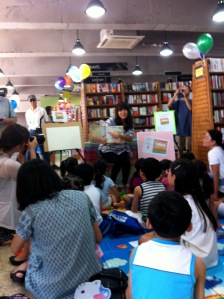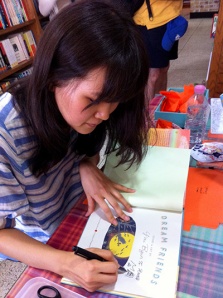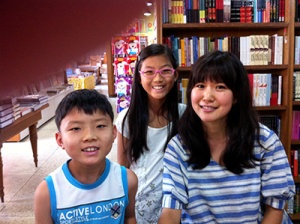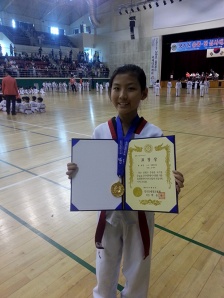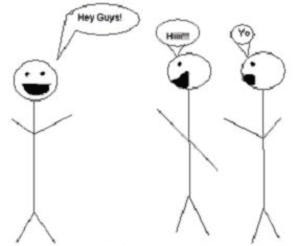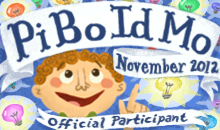My writing blog has moved to tinamcho.com. Yes, I bought my own domain. Please come visit me there and subscribe if you’d like to continue reading my posts. Thanks so much!!
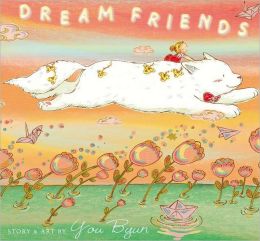 On August 24, my kids and I attended our first author/illustrator book signing! You Byun of Brooklyn, New York was in Seoul signing at our English bookstore for her debut picture book Dream Friends, published by Nancy Paulsen Books, Penguin Group. I had signed my kids up for this story time last week.
On August 24, my kids and I attended our first author/illustrator book signing! You Byun of Brooklyn, New York was in Seoul signing at our English bookstore for her debut picture book Dream Friends, published by Nancy Paulsen Books, Penguin Group. I had signed my kids up for this story time last week. I used my kids as an excuse to attend; this book signing was really for me to observe. 🙂
I had first heard of Dream Friends from an interview at Writer’s Digest: 7 Things I’ve Learned So Far. Then I actually got to read her new book on the web site We Give Books. (It’s not part of their collection anymore that I could find.) And then my 12×12 writing friend, Sylvia Liu interviewed You Byun on her blog, Sylvia Liu Land. Here You Byun shares how she got her first book contract and what she’s working on. I also “friended” You Byun on Facebook and Twitter. So I messaged her that I was so happy she’d be in Seoul and told her I was a member of the SCBWI (Society of Children’s Book Writers and Illustrators), too.
You Byun read her story.
She shared her original drawings and explained how she used the computer to make final illustrations.
Autographing books is more fun if the illustrator draws you!
My kids and You Byun
What did I learn? I learned you must be very organized at book signings with children and parents expecting great things from you, speak in a loud voice, have something for the kids to take away (She taught them how to draw a character.), have fun prizes, but most of all, control the crowd, where the teacher in me wanted to get the children to be quiet. Oh, and as a bonus, I met the assistant sales manager of Penguin Group Korea! She said in the future they might publish their own English books because right now they’re all published in the U.S.
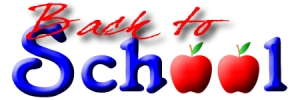 It’s back to school time! As soon as my “seems-to-be-lost” box arrives from Iowa full of curriculum, we’ll begin our homeschool. But not only are my kids back to school, I am, too!
It’s back to school time! As soon as my “seems-to-be-lost” box arrives from Iowa full of curriculum, we’ll begin our homeschool. But not only are my kids back to school, I am, too!
In July I won 4th place in author Susanna Leonard Hill’s 4th of July writing contest, which got me a free ticket into her online picture book class called, Susanna Leonard Hill’s Picture Book Magic! So I’m currently in the middle of Susanna’s class and revamping one of my stories. Before I won this great opportunity, I had signed up for Dr. Mira Reisburg’s Picture Book Academy, The Craft and Business of Writing Children’s Picture Books. That class starts Aug. 26th. So both my children and I will have homework for the next couple of months!
If you want to go back to school and shape up some of your stories and learn new techniques, consider these opportunities!
 Greetings from Iowa! My kids & I are having a vacation at my parent’s house for the month of July, and we’re definitely enjoying being back in the states! For me, I’m trying to catch up on all the picture books I’ve missed for the past three years! And my mom’s library has an UNLIMITED book check-out! This is great because I’m following author Pam Calvert’s Picture Book University lessons on her blog. You can follow along, too. Just click the badge. I especially like her lesson about character-driven books, which editors and agents seem to want.
Greetings from Iowa! My kids & I are having a vacation at my parent’s house for the month of July, and we’re definitely enjoying being back in the states! For me, I’m trying to catch up on all the picture books I’ve missed for the past three years! And my mom’s library has an UNLIMITED book check-out! This is great because I’m following author Pam Calvert’s Picture Book University lessons on her blog. You can follow along, too. Just click the badge. I especially like her lesson about character-driven books, which editors and agents seem to want.
By the way, thank you for reading my story on my previous post, Fishing Boat to Freedom. I did take it down, in case I decide to submit it. But it won 4th place in author Susanna Leonard Hill’s contest. So thanks so much!
I know it’s supposed to be summer break, and thankfully we completed homeschool last week. We’ll do math “camp” a few days a week through June. While I’m reading of so many writing friends enjoying vacations and conferences, I’m stuck in my chair writing. Yep, I’m now on my 3rd educational project in a ROW. And while I enjoy keeping on top of things in education, writing to tight deadlines keeps me busy. But just as the verse in the Bible says, what you sow, you reap, I do love reaping the crop of books! Let me share some with you…
This month in June’s Clubhouse Jr, I have a rebus story. I haven’t received mine yet, but when I do, I’ll let you know more details. They even kept my children’s names in my story. A year ago, my kids bought insect nets and tried to catch the million dragonflies that zoom around here in late summer. So I wrote a rebus, and it sold right away! So while you’re out and about this summer, keep your notebook handy and look for story lines!
Another unique opportunity that ANY of you could do is freelance write or edit for ESL/ELL books, not only in the U.S. but overseas. In Asia, especially in Korea, English is BIG. To get ahead of the other million kids, children attend English academies after school. Some young children go overseas for 3-5 months to learn English. These ESL/ELL companies need native speakers and writers. Anyway, an editor at my church in Seoul who works for a Korean/English publisher found out I write. She told her boss about me, and last year I helped write and edit middle school English books for them. These are textbooks “foreign language” English teachers in Korean middle schools will use. Trying to write English grammar and seeing how Koreans learn it was an eye opener for me. This company’s three middle school books are finished. (see photo) The government approved them, and public schools can adopt them in 3 years. What?! Why the wait? I have no idea why. I think they adopt books every four years. Now they just contracted me again to help with a supplement grammar book for the same age group. This keeps me on my grammar toes! So look for these opportunities. I’ve seen some posted previously in educational market ads. They pay well, and it’s a great experience. I even landed my name in the credits. 🙂
Sorry I’ve been MIA again, but freelance writing deadlines demand my time and attention as of late! But I do have a blog post for you, just not here. I’m a guest blogger at the fabulous Donna L. Martin’s Writerly Wisdom series. Today I share how to write a nonfiction proposal–that is, what works for me. (I just thought–because of my nonfiction proposals landing contracts, that’s one of the reasons why I haven’t blogged!) So head on over, when you have the chance!
Donna L. Martin’s On the Write Track Blog
Oh, and Donna shares that we have taekwondo in common. My children both take it every week day for 1 hour here in Korea. I’m the proud mommy because my daughter received a medal for her red/black combination belt or 1st “poomse.”
When I taught early elementary grades, I loved collecting stuffed animals and anything that had to do with an author’s picture books. I still have a Very Hungry Caterpillar baby rattle that served a dual purpose–for my baby but also to bring to my kindergarten class when we read the famous book.
However, NOW, anyone can make their own fabric characters to go along with their picture books. I just discovered this on two blogs today. First, are you familiar with Joyce Wan’s bright, colorful, and simple illustrations? She has taken her adorable cupcake character and made her own fabric using a site called Spoonflower. Check out her pillows to go with her books here. And then check out her fabric which she designed here.
Second, the U.K. publisher, Nosy Crow, has a new picture book titled Shifty McGifty and Slippery Sam. Look at how illustrator Steven Lenton is marketing his book! Incredible! He, too, designed his own fabric and made those adorable gift cushions to go with the book. Awesome marketing! I love the flyers, too.
A writing friend just alerted me to illustrator Paul O. Zelinsky’s Spoonflower page here. You can see his fabric for his popular picture book Z is for Moose. He has a shirt made from his fabric of characters.
So I’m making mental notes of these neat things for someday when I have a cute character in a book. Plus, I have a mom who sews!! In the meantime, I enjoyed browsing at Spoonflower. You can design your own fabric, wallpaper, decals, and gift wrap. I even saw Lego fabric. My son would love that.
 Artistic temperament sometimes seems a battleground, a dark angel of destruction and a bright angel of creativity wrestling. ~Madeleine L’Engle
Artistic temperament sometimes seems a battleground, a dark angel of destruction and a bright angel of creativity wrestling. ~Madeleine L’Engle
Creativity comes from looking for the unexpected and stepping outside your own experience. ~Masaru Ibuka
What do you do to bolster your creativity? The other day I needed to develop a craft for the book I’m currently writing for Legacy Press, and for the life of me, I just couldn’t come up with any good ideas. I put it aside, worked on other things, went for a jog by the river, returned to my desk, but still NADA! Finally, I remembered PINTEREST! Duh! That’s where I should have gone first. If you’ve never used this pin board, it’s a wonderful place for creativity. People pin photographs of things that are meaningful to them, recipes to try, books to read, hairstyles and clothing, just about anything! So I love to look there for ideas, that is, if I remember. Mind you, for this book I can’t copy a craft, but just being in a virtual place staring at boards of awesome creative ideas is wonderful for my brain. Somehow, it got the wheels turning, and I came up with a unique craft that had absolutely nothing to do with what I was even staring at.
So my take-away lesson is that if we want to be creative or find ideas, we need to be in a place surrounded by creativity. If we want to be wonderful writers, we have to surround ourselves with writings and teachings of other great writers. If we want to find ideas for children’s books, we must surround ourselves with children. Seems like very simple logic, but sometimes I think I forget.
What do you do to unearth your creativity? If you want to look me up on Pinterest, I’m at http://pinterest.com/tinamariecho/
I’m not on there a whole lot, as I have much to write and homeschool. But it’s a fabulous place, if you’ve never been.
I’m up to my elbows in “green” topics as I’m in the middle of writing a book for Legacy Press Kids, which is a chapter book with 10 chapters. This book is unique in that it’s classified as nonfiction; however, each chapter has a fiction story for 8-12 year-old-girls along with nonfiction facts, puzzles, activities, crafts, and devotions. I’ve never written a regular chapter book or novel, but this is great practice. I’m actually continuing the same characters this time throughout the book and adding new friends along the way. I’m also aware of my age group so that I use the proper sentence length and vocabulary. So that brings me to my book review below, which includes a section on how to write chapter books. I thank God I was in writing groups with Nancy I. Sanders. She basically taught me everything I know about writing. Now that we’re thousands of miles away, I still hound her and ask her questions. She’s an award winning author of over 80 books and does a superb job teaching others how to write.
 Book Review: Yes! You Can Learn How to Write Beginning Readers and Chapter Books by Nancy I. Sanders, 2012
Book Review: Yes! You Can Learn How to Write Beginning Readers and Chapter Books by Nancy I. Sanders, 2012
If you’d like to write for the educational market or just learn the differences between beginning readers, this is the perfect book. Nancy explains in detail the structures of the following: pre-emergent readers, emergent readers, easy readers, advanced readers, first chapter books, and hi-lo readers. Whew! She also touches on writing for children’s magazines and how to write a rebus.
If you want to know the nitty-gritty of this world of beginning readers, Nancy starts with the history of how it all came to be, reading levels, standards, word lists, etc…
Each reader section gives concrete examples of the structure: vocabulary, number of words in each sentence, characters, dialogue, plot, setting, topics and themes. She shows you how it all works together under very tight guidelines. I know. I’ve done it! See photo.
I appreciate Nancy’s expertise in sharing tips and strategies along with little assignments you can do to practice writing for this age group. Since chapter books are new to me, when I have some extra time, my kids are hounding me to write one. I’ll definitely use her chapter to help guide me. 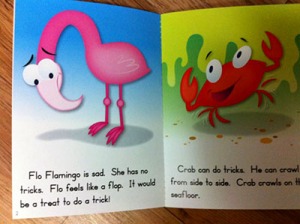
The back of the book has a wonderful glossary. When I started writing in 2008, I knew none of the writer lingo and was constantly asking Nancy questions, like why do they call publishing houses a house? What is a royalty check? So this is very helpful for beginning writers as well.
So if you’re interested in writing beginning readers or beginning chapter books, check out this book! Writing for this age group is so much fun!
[This is a spread from my guided reading book Flamingo’s Tricks published by Lakeshore Learning 2011. These are phonic readers, and each book correlated to specific sounds. This one corresponded to blends.]
If you’d like to get a feel for Nancy’s book, click here to read the transcript of a workshop she led on beginning readers for the Institute of Children’s Literature, March 2013.

